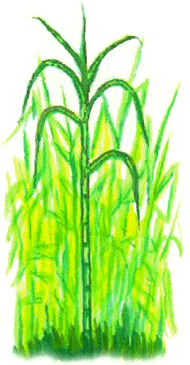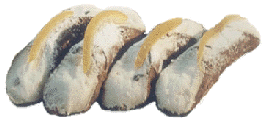...Best of Sicily presents... Best of Sicily Magazine. ... Dedicated to Sicilian art, culture, history, people, places and all things Sicilian. |
by Roberta Gangi | ||
Magazine Index Best of Sicily Arts & Culture Fashion Food & Wine History & Society About Us Travel Faqs Contact Map of Sicily |
Traditional cane "refining" was essentially a crushing, extraction and crystallization process, adding water to a paste which dried to become "sugar." The medieval product was coarse and slightly brownish in hue, though for pastry making it was usually crushed into a fine powder or melted. Before the introduction of cane sugar, honey was used as a sweetner in most Sicilian recipes. The English word sugar comes to us, via the Italian zucchero and then the Old French sukere, from the Arabic sukkar. The Normans of medieval Sicily probably coined the French word directly from the Arabic. (During the same period, crusading knights returning to England from the Middle East brought news of the cane with them.) The Arab influence radically changed Sicilian cuisine, with the widespread cultivation of various fruits which previously were unknown (or virtually unknown) in southern Europe. In Sicily, the evolution of pastries was also influenced by pre-existing flavors. Ricotta cheese made from sheep's milk was sweetned with powdered sugar to form the cream still used as a filling today, particularly in sfingi, cassata and cannoli (the tubular confection shown here). It is the strong flavour of the sheep's milk that gives this ricotta cream its distinctive taste; outside Sicily the ricotta made with cow's milk is rather bland by comparison. Some sugar cane grows wild in Sicily today, though most of the tall,
reed-like cane plants one sees growing near streams are not sugar cane.
Sugar cane refining yields a product that is about 20% sucrose. Soft but
crystalline brown sugar, when further refined, results in white sugar. Molasses,
which is not crystalline, is a by-product of cane sugar production. Sugar
Sicilian sugar cane cultivation gradually declined beginning in the 1400s, probably as a result of the climate becoming somewhat dry compared to its medieval condition, and also the abandonment of the Arabs' effective irrigation systems. By the 1700s, with sugar cane being cultivated in various tropical countries (and imported into Europe), Mediterranean production decreased generally. A hard freeze will kill sugar cane, which is propagated by planting a piece of stem. With increasing cultivation of cane in the New World, it became practical to harvest it where it was grown, while refining it in special "refinery" plants in Europe. (The Venice refinery was famous; the hard "confetti" candy produced in the Veneto region was made from sugar produced there.) It is difficult to contemplate a world without sugar (or without the various products invented as a substitute for it). Marzipan and candied fruits, both attributed to Arab confectioners, became popular in Sicily with the widespread use of sugar from cane. So did chocolate --not only the "native" Sicilian variety but the delicious confection we know today. Sugar is also added to certain liquors. About the Author: Roberta Gangi has written numerous articles and one book dealing with Italian cultural and culinary history, and several food and wine articles for Best of Sicily Magazine. | |
Top of Page |
 Sugar changed the face --and taste-- of medieval Sicilian
cuisine, and its delicious effects can still be enjoyed
today. Saccharum officinarum (loosely translated "noble cane")
probably originated in Polynesia, to be introduced in India and China in
antiquity, though some genetic research suggests a mainland Asian origin.
The Persians were producing sugar from cane by 500 BC, if not
earlier. With the Arab invasion of medieval Persia in 642, early sugar cane
refining techniques were acquired by eastern Mediterranean peoples. By 900,
the cane was being grown in Arab Sicily, one of the few European regions
where this tropical plant has ever been grown. Sugar cane needs a humid,
tropical climate, with plenty of precipitation (or irrigation). The Arabs
were experts at designing efficient irrigation systems, and in the tenth
century Sicily had more rivers and natural lakes (and more rain) than it
does today. Broadly classified as a perennial grass, sugar cane grows to
a height of over three meters (ten feet). Notwithstanding good irrigation
methods, sugar cane usually was grown in Sicily's flat coastal areas, which
in the Middle Ages were often marshy, particularly near Catania, Marsala
and Trapani.
Sugar changed the face --and taste-- of medieval Sicilian
cuisine, and its delicious effects can still be enjoyed
today. Saccharum officinarum (loosely translated "noble cane")
probably originated in Polynesia, to be introduced in India and China in
antiquity, though some genetic research suggests a mainland Asian origin.
The Persians were producing sugar from cane by 500 BC, if not
earlier. With the Arab invasion of medieval Persia in 642, early sugar cane
refining techniques were acquired by eastern Mediterranean peoples. By 900,
the cane was being grown in Arab Sicily, one of the few European regions
where this tropical plant has ever been grown. Sugar cane needs a humid,
tropical climate, with plenty of precipitation (or irrigation). The Arabs
were experts at designing efficient irrigation systems, and in the tenth
century Sicily had more rivers and natural lakes (and more rain) than it
does today. Broadly classified as a perennial grass, sugar cane grows to
a height of over three meters (ten feet). Notwithstanding good irrigation
methods, sugar cane usually was grown in Sicily's flat coastal areas, which
in the Middle Ages were often marshy, particularly near Catania, Marsala
and Trapani. cane
syrup, which may be produced as an alternative to actual
sugar, is used in liquors and various foods.
cane
syrup, which may be produced as an alternative to actual
sugar, is used in liquors and various foods.